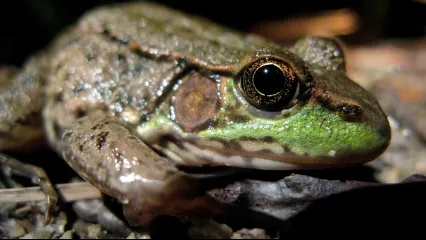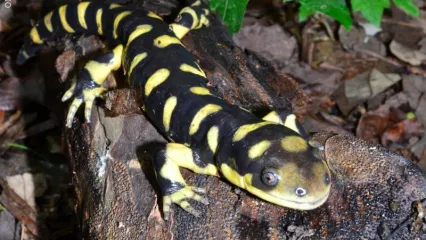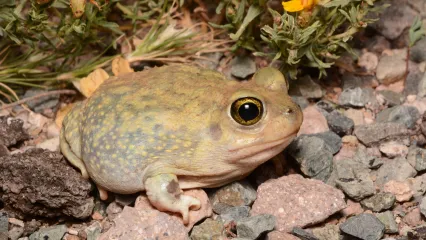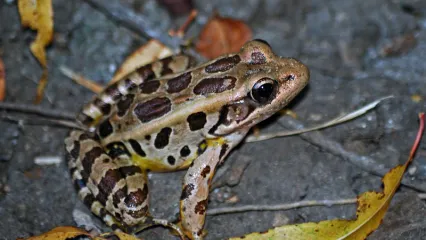
Description
Green frogs are relatively large, robust frogs. Although the frogs in many populations are green, they can also be bronze, yellow-brown, brown, or many shades of greenish-brown. The dorsal skin is rough and a broken dorsolateral fold extends from behind the eye on each side of the back to mid-body. The legs are banded in some individuals but have broken irregular spotting in others. The venters are white, although males may have yellow throats. In males, the tympanum (external eardrum) is large, sometimes twice as large as the eye, and is dark brown with a lighter brown spot in the center. In females, the tympanum is the same size as the eye. The iris of the eye is bronze with black reticulations.
The only remotely similar frog is the bullfrog. Green frogs have a ridge-like broken dorsolateral fold along the side of the body; bullfrogs do not.
Tadpoles of the green frog can reach up to 5 inches in total length in some parts of their range, but they are typically smaller (2.5 to 3 inches). The bodies are brown with fine darker brown, dense mottling. The tail and tail fins are lighter brown with some mottling. In the southern parts of their range, including Oklahoma, they generally require three months to reach metamorphosis. In more northern parts of their range, they overwinter and require up to 22 months to metamorphose. During the breeding season, males defend small territories along the shorelines of permanent bodies of water. They call while floating in water.
The advertisement call is a short note that sounds like the twang of a banjo. A low growling call may be made in response to another frog entering a caller’s territory.
Size
Males are generally smaller than females in this species. In Oklahoma, large females can reach 4 inches in length, whereas males typically range in size from 2.5 to 3 inches. Frogs in northern populations are larger than those in the south.
Habitat
In Oklahoma, green frogs occur throughout most of the eastern half of the state. Outside of Oklahoma, they have a wide distribution, occurring from southern Canada throughout much of the eastern half of the U.S.
Life Cycle
Green frogs are primarily summer breeders. In Oklahoma, breeding begins in April and extends throughout the early summer to late June or July, depending on weather conditions. Adults can be found in permanent bodies of water, such as lake edges, ponds, marshes, swamps, or oxbows. They remain around the same types of habitats when not breeding. Males call while floating in shallow water. Eggs are laid among aquatic vegetation in shallow water, and hatching occurs within a few days. A surface film of eggs may contain from 1,000 to 7,000 eggs. Some females have been reported to breed twice in one season; the second clutch is usually considerably smaller than the first one.
How To Observe
Green frogs are not easy to observe. They superficially resemble bullfrogs and leopard frogs, so they must be distinguished from these species. They stay around the shorelines of their habitats during the day and may be seen hopping into the water if disturbed. Their calls are commonly heard around permanent bodies of water on summer evenings, so the best way to locate them is to locate a pond where individuals are calling and shine a flashlight around the pond. Once eyeshine is located, the frog can be easily found.
(This profile was created by Dr. Laurie Vitt as part of a partnership between the Wildlife Department and the Sam Noble Oklahoma Museum of Natural History. It was funded as part of a larger State Wildlife Grant to survey and inventory amphibians and reptiles of the Wildlife Management Areas of Oklahoma: T-35-P-1.)


